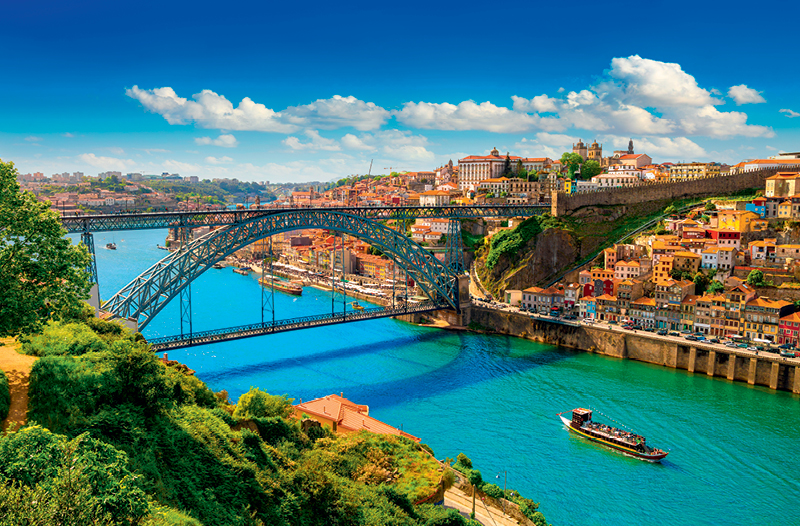
Iceland: Big Wows, Small Package

Iceland is physically being torn apart.
WHEN TO GO
Avoid the dark winter months from December to March when there’s scarcely any daylight. April, May and September are ideal times to visit with generally drier and brighter weather.
CURRENCY
Króna, $1 = 142 ISK
LANGUAGE
Icelandic, but everyone speaks perfect English, as it’s widely taught in schools.
COMPANIES TO CONSIDER
Hurtigruten, Viking, Ponant, Intrepid
The island nation sits on two tectonic plates that act more like political parties than neighbors, both moving steadfastly in opposite directions. Now, you might think you should avoid a destination that’s slowly being ripped apart by geologic forces, but that’s precisely why you should go there.
This constant shifting of landmasses, in collaboration with the island’s northerly bearing between Norway and Greenland, has created an epic battle between fire and ice. Volcanoes emerge to periodically roar their fiery breath into the ice-cold sky. Massive canyons, ancient glaciers and deep craters have formed over eons, rippling the landscape with immense rises and falls in elevation. Artfully crafted bays are outlined with rock-strewn, black-sand beaches that contrast vividly with the radiant green glow of the Northern Lights.
Iceland is a nature lover’s paradise, a rugged place of fierce, unworldly beauty unlike any other on earth. Simply put, it does not disappoint, especially when you add in the country’s cutting-edge architecture, Viking heritage, and thriving art and music scenes. And at roughly 40,000 square miles—meaning it can fit into the state of Colorado with space to spare—the entire nation and all its natural gifts can be easily explored in one, tidy vacation. Here are the highlights.

Start in Reykjavic
Most journeys to Iceland begin and end in the stunning capital city of Reykjavik, but you should make one quick pit-stop on your way there. Since the flight to Keflavik Airport takes around six hours from the east coast, chances are you’ll arrive a bit deflated and travel-worn. Good news: just 20 minutes from the airport sits the Blue Lagoon.
The country’s most famous geothermal pool, the Blue Lagoon is an ethereal pond of iridescent turquoise waters heated by volcanic vents far below the surface. When you step into the mineral-rich basin, it will be a perfect 100 degrees, the ideal temperature to feel the weariness leave your bones as you soak in your mist-shrouded surroundings. The entire area has turned into a spa resort, complete with a hotel, multiple restaurants, even a swim-up bar. Without leaving the water, you can exfoliate with a frozen lava-rock scrub mask while sipping a glass of wine. From October through April, you can even spot the dancing green and purple lights of the aurora borealis while pleasantly submerged—now there’s a moment you won’t soon forget.
Once revived and rejuvenated by the healing waters, hop back on the road and head into Reykjavik, the world’s northernmost capital. The ancient city likes to keep you guessing. It’s cosmopolitan in spirit and culture, but it also has a small-town vibe with very few buildings reaching over five stories, making it easy to explore on bike. It’s also young at heart, home to a vibrant music and art scene, but it has an ancient soul, dating back to 874 A.D. when it was first settled and named “smokey bay” in the native tongue, a reference to the geothermal steam rising from the area’s numerous hot springs.
Your first act is to head to Hallgrímskirkja, a striking modernist church with an iconic stepped-concrete façade. One of the tallest buildings in the country at 244 feet high, it’s ideal to climb the tower for a fantastic view of the capital. Afterward, your options are many. Swim in the artificially warmed waters off of Nauthólsvík, a tiny crescent-shaped beach of imported golden sand. Catch a performance at Harpa, a cultural and social center with stunning views of the surrounding snow-tipped mountains and the North Atlantic Ocean. Or dive into the island’s intriguing past at either the National Museum of Iceland or the Settlement Exhibition, which is housed in the remains of an ancient hall from the Settlement Age.

Then Go for a Drive
The best way to explore Iceland is to rent a car and drive. Whether you’re motoring down one of its established scenic routes or Google Maps-ing it to small towns to find that vegan joint you saw on Instagram, you’ll enjoy the country’s empty roads, clear signage and non-aggressive drivers. Plus, the freedom and flexibility of driving yourself means you can custom-tailor your adventure however you wish.
There are many official drives that showcase the best this island has to offer, including the Arctic Coast Way along the island’s northern coastline and the Westfjordsway that gently rolls nearly 600 miles through the dramatic landscape of the Westfjord peninsula. But if you’re looking for Iceland’s greatest hits, the Ring Road is your route.
One of the greatest drives in the world, the Ring Road—or, more officially, Route 1—is an 820-mile paved highway that circumnavigates the island, throwing in a few well timed detours along the way. While a 4×4 is required to traverse some of Iceland’s more remote roads, any vehicle will do for the Ring Road—just make sure its brakes work, for you will want to stop often to admire the view.
Throughout your drive, you’ll be endlessly fascinated by the ever-changing landscape. Narrow cliffs, spurting geysers, glacial rivers, volcanic mountains and rushing waterfalls will cause you to pull over again and again, so give yourself plenty of time to enjoy the drive. You’ll often go miles without passing another car or even spotting a shop, though you will see your fair share of tiny fishing villages along the way.
Highlights of the Ring Road are many. They include the Skagafjordur Folk Museum, full of old farmhouses roofed with turf; mighty Skógafoss falls, which is fed by two glaciers and pours over Iceland’s former southern coastline; Jökulsárlón, a glacial lagoon fringed by a black-sand beach spotted with broken chunks of icebergs; Thingvellir National Park, a jaw-dropping rift valley created by the separation of tectonic plates; Eyjafjallajökull, the unpronounceable volcano that stopped the world when it erupted in 2010; and Skaftafell Park, a must-see destination on the edge of the Vatnajökull Glacier.
Yet while the Ring Road can boast a mighty fine collection of sites, the 155-mile Golden Circle may have it beat. Easy to complete on a full-day’s drive from Reykjavik, this route will take you to the geothermal area in Haukadalur, where the geyser Strokkur reliably gushes boiling hot water every 10 minutes up to 98 feet in the air, as well as to the UNESCO-designated Thingvellir National Park, a geological wonderland where the Icelandic parliament met in 1944 to declare independence from Denmark.
The main site on this popular route is Gullfoss, aka the Golden Falls. Heaving the Hvítá River over a three-step tier of twisting platforms before plummeting it into a deep, rocky crevice, the waterfall is photogenic from every angle. The best part is that this celebrated site—which would be a mega-attraction in most other nations—is visited by only a mere 2,000 people a day.
That’s the way you’ll find a lot of Iceland. One stunning natural wonder after another, and you’ll often feel like you have them all to yourself. Even the cities and towns are sparsely populated, with the charming port city of Akureyri, the nation’s second largest, boasting only 18,000 extremely friendly citizens. Iceland is not a secret travel destination, but it is a place few people visit. And that might be why it’s such a perfect place to go.

Icelandic cuisine is based on the conditions locals have lived with for centuries. Limited sunlight caused a lackluster farming environment. Small, rocky fields made it difficult to raise animals. And its northern, near-Arctic position kept it out of the trade routes. As a result, they developed one of the most unusual culinary scenes you’ll ever enjoy. Here are the can’t-miss dishes.
Plokkfiskur—Fish Stew > This go-to traditional Icelandic staple includes boiled cod or haddock alongside mashed potatoes and raw onions covered with a delicious white sauce.
Harðfiskur—Dried Fish > One of the island’s most popular foods, it’s made similarly to cheese: cod, wolffish or haddock is dried in the bitter North Atlantic air and then cured by bacteria culture.
Humar—Icelandic Lobster > A smaller specimen akin to langoustine, it can be fried, grilled, baked and even found as a topping on your pizza.
Hákarl—Fermented Shark > Not for the faint of heart, Hákarl is a potent-smelling hunk of shark that has been fermented for up to five months.
Kleinur—Twisted Donut > This mouthwatering crispy donut featuring nutmeg and cardamon was once a Christmas-only treat until locals realized how delicious it is year-round.
Flóki Whiskey > Named after the first settler who stepped on Icelandic soil, this stout beverage is made only from local ingredients and has hints of vanilla, white coffee, fresh bread, pepper and bubblegum.

While driving is a great way to explore the volcanic interior of Iceland, cruising around the entirety of the island gives you another breathtaking perspective. Often booked as roundtrip journeys from Reykjavik or international jaunts involving Norway, these small-ship sailings provide a front-row seat to ice-strewn bays and a fjord-cut coastline, giving you a peep at remote places that land tourists often miss. Here are some highlights.
Isafjördur > Founded in the ninth century by Vikings and now the biggest town in the Westfjords, this fishing center boasts a scenic old town, numerous museums and the Museum of Everyday Life, known as the Hversdagssafn, or Hvers Museum, home to commonplace objects that reveal beauty in the mundane.
Stykkishólmur > There’s a lot to do in this town of about 1,100 people, including seeing the oldest two-story building in Iceland, heading to Snæfellsnes Peninsula National Park, and checking out the Library of Water, an art installation consisting of glass columns filled with water collected from glaciers around the island.
Húsavík > Often called the whale watching capital of Europe, the waters here enjoy frequent visits from humpback and minke whales, white-beaked dolphins and even the elusive blue whale. And wherever you venture to spot whales, odds are you’ll run into a colony of puffins too.
Seydisfjördur > Pronounced “say-this-further,” this scenic village enjoys a mountainous setting at the end of a fjord. Hiking is big here, with trails taking you past colorful wooden homes and starkly picturesque slopes all the way to the soaring summit of Mt. Bjólfur.
Djúpivogur > This former ghost town has been transformed into a magical place thanks to the towering Búlandstindur, a mountain famed for granting wishes during the summer solstice. The town has adopted a “cittaslow” way of life, which is dedicated to sustainable living.





